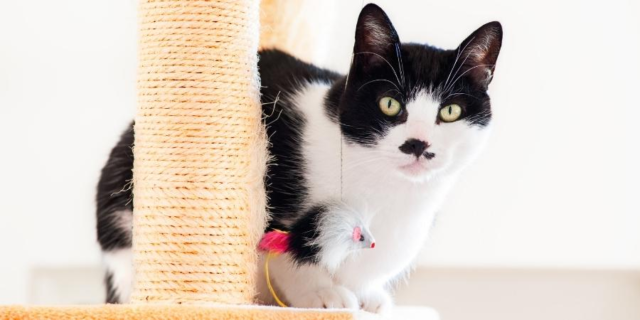The UK is undoubtedly a nation of animal lovers, with recent research from PDSA, the vet charity for pets in need, finding that more than half of British adults own a pet (52 per cent).
Recent government proposals mean that landlords must consider any request for pets to live in their property and allow tenants to challenge their decision, which will be welcome news to many pet owners.
However, a boost in the number of pets living in rented properties does increase the potential for accidental damage. Here, PDSA Vet Nina Downing shares her advice for keeping homes in tip-top condition when living with furry family members.
Chewing and scratching
Scratching and chewing are instinctive behaviours but aren’t ideal when directed towards furniture, walls or carpets. These habits can stem from boredom, so it’s important that pets are well exercised and have plenty of things to keep them stimulated.
Scratching posts are great for playful cats, while interactive puzzle toys that dispense treats will keep both cats and dogs entertained – just remember to change toys regularly to keep it exciting. Indoor rabbits will also need lots of opportunities to play and dig like they would in the wild.
Chewing is natural for dogs and completely normal, but destructive behaviour can sometimes be a sign of separation anxiety. Dogs are naturally social animals and can become stressed if they’re left alone, so teaching independence early on can help to stop the problem developing. If you think your adult dog suffers from separation anxiety, you should speak to your vet or an accredited behaviourist for advice.
Each dog’s coping ability is different, but no dog should be left alone for more than four hours. If you are planning to spend longer out of the house, ask a friend to pop in, or use a professional dog-sitting or walking service to keep them company.
All dogs should be given the chance to chew if they want to, so make sure they have plenty of safe toys for this. For extra prevention against pesky bite marks where you don’t want them, a safe chew-repellent will help protect furniture and fittings around the home. These have a bitter taste that discourages chewing – but remember they’re a temporary solution and you must help your dog to learn they need to chew the right things instead.
Stains
Preparation is key here. If your dog loves getting mucky outside, keep a towel near the doorway for a quick clean before they enter and try to keep them on hard floors while they dry off, as this will keep smells at bay too.
Soft furnishings can easily be soiled by muddy paws, but cleaning wet spots immediately will help prevent stains becoming permanent.
For toilet mishaps, soak up as much liquid as possible and use a pet-friendly stain remover. It’s a good idea to choose a scent-free option, as strong smells can sometimes encourage marking. To keep these incidents to a minimum, place cats’ litter trays throughout the house and ensure they’re refreshed regularly. For dogs, make sure they have plenty of opportunity to go to the toilet outside.
Pet hair
Pets naturally shed hair, which can make it seem impossible to keep your home fur-free. Grooming should be a priority for any breed and is one of the best ways to speed up the shedding process and limit hair around the home – just introduce it gradually to get your pet used to it.
For pooches who enjoy lazing on the sofa, a heavy-duty throw will help prevent fur from transferring, and offer a layer of protection against curious claws which can easily damage soft fabrics. Remember to wash throws regularly to keep your home smelling its best.
Damage to lawns and gardens
Dogs’ urine contains high levels of nitrogen, which can over-fertilise and burn grass, resulting in discoloured spots. To avoid this, restrict access and train your pooch to do their business elsewhere, such as in a gravelled area.
If this isn’t possible (or practical), rinsing the spot with a watering can or hosepipe after they toilet will minimise the damage. Encouraging dogs to drink plenty of water will also dilute their urine as well as keep them hydrated. Pet water fountains are a great idea, as many cats and dogs prefer running water – you could also add water to their food.
For more information on moving with pets, visit: https://www.pdsa.org.uk/pet-help-and-advice/looking-after-your-pet/all-pets/moving-home-with-your-pet




